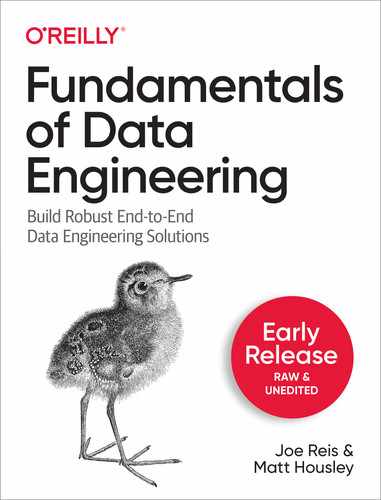Data engineering has grown rapidly in the past decade, leaving many software engineers, data scientists, and analysts looking for a comprehensive view of this practice. With this practical book, you'll learn how to plan and build systems to serve the needs of your organization and customers by evaluating the best technologies available in the framework of the data engineering lifecycle. Authors Joe Reis and Matt Housley walk you through the data engineering lifecycle and show you how to stitch together a variety of cloud technologies to serve the needs of downstream data consumers. You'll understand how to apply the concepts of data generation, ingestion, orchestration, transformation, storage, governance, and deployment that are critical in any data environment regardless of the underlying technology. This book will help you:
Table of Contents
- 1. Data Engineering Described
- What Is Data Engineering?
- Evolution of the Data Engineer
- Data Engineering Defined
- Data Engineering and Data Science
- Data Engineering Skills and Activities
- Data Maturity and the Data Engineer
- The Background and Skills of a Data Engineer
- Business Responsibilities
- Technical Responsibilities
- The Continuum of Data Engineering Roles, from a to B
- Data Engineers Inside an Organization
- Internal Vs External Facing Data Engineers
- Data Engineers and Other Technical Roles
- Data Engineers and Business Leadership
- Summary
- Further Reading
- Links
- 2. The Data Engineering Lifecycle
- What Is the Data Engineering Lifecycle?
- The Data Lifecycle Versus the Data Engineering Lifecycle
- Generation - Source Systems
- Ingestion
- Storage
- Transformation
- Serving Data for Analytics, Machine Learning, and Reverse Etl
- The Major Undercurrents Across the Data Engineering Lifecycle
- Data Management
- Orchestration
- Dataops
- Data Architecture
- Software Engineering
- Chapter Summary
- Further Reading
- Data Transformation and Processing
- Undercurrents
- Further Watching
- 3. Choosing Technologies Across the Data Engineering Lifecycle
- Cost Optimization: Total Cost of Ownership and Opportunity Cost
- Total Cost of Ownership
- Opportunity Cost
- Today Vs the Future - Immutable Vs Transitory Technologies
- Our Advice
- Location: On-Prem, Cloud, Hybrid, Multi-Cloud, and More
- On-Premises
- Cloud
- Hybrid Cloud
- Multi-Cloud
- Decentralized - Blockchain and the Edge
- Be Cautious with Repatriation Arguments
- Our Advice
- Build Vs Buy
- Open-Source Software (Oss)
- Proprietary Walled-Gardens
- Our Advice
- Monolith Vs Modular
- Monolith
- Modularity
- The Distributed Monolith Pattern
- Our Advice
- Serverless Vs Servers
- Serverless
- Containers
- When Servers Make Sense
- Our Advice
- Undercurrents and How They Impact Choosing Technologies
- Data Management
- Dataops
- Data Architecture
- Orchestration
- Software Engineering
- Summary
